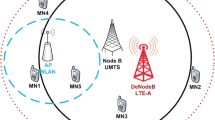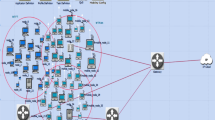Abstract
Traditional multi-criteria decision making (MCDM) algorithms are used in the handover of user equipment (UE) in an Ultra Dense Network (UDN). UDN refers to the increased density of the Radio Access Technologies (RATs) in a region which leads to the overlapping of the areas covered by individual RATs. MCDM algorithms such as TOPSIS, PROMETHEE and SAW are used to initiate handovers between these RATs based on the parameters obtained by the UE from each of the overlapping networks. However, initiating a handover abruptly and frequently, in case of availability of a new RAT without any thresholding technique proves to be unfriendly to the system resources. This can degrade the performance of the system. In this paper, a thresholding approach to the handover procedure is integrated to the MCDM process for the selection of RATs. First, an application-specific approach has been used in the selection of weights using the analytical hierarchy process which, is depending upon the application being used by the user. Then the ranking of the available RATs is done using the various MCDM algorithms and depending on the threshold specified for a handover, a decision is made whether to perform the handover process or not. In the case of streaming class of network traffic, the proposed method improves the performance of the system and reduces the handover by 13.14%, 19.35% and 8.62% of RAT modifications for TOPSIS, PROMETHEE and SAW respectively.








Similar content being viewed by others
Code availability
Custom Code.
References
Lauridsen, M., Gimenez, L. C., Rodriguez, I., Sorensen, T. B., & Mogensen, P. (2017). From LTE to 5G for connected mobility. IEEE Communications Magazine, 55(3), 156–162.
Prados-Garzon, J., Adamuz-Hinojosa, O., Ameigeiras, P., Ramos-Munoz, J. J., Andres-Maldonado, P., & Lopez-Soler, J. M. (2016). Handover implementation in a 5G SDN-based mobile network architecture. In Proceedings of the IEEE 27th annual international symposium on personal, indoor, and mobile radio communications (pp. 1–6).
Basloom, S., Akkari, N., & Aldabbagh, G. (2019). Reducing handoff delay in SDN-based 5G networks using AP clustering. Procedia Computer Science, 163, 198–208.
Tayyab, M., Gelabert, X., & Jäntti, R. (2019). A survey on handover management: From LTE to NR. IEEE Access, 7, 118907–118930.
Ge, X., Li, Z., & Li, S. (2017). 5G software defined vehicular networks. IEEE Communications Magazine, 55(7), 87–93.
Liu, G., Huang, Y., Wang, F., Liu, J., & Wang, Q. (2018). 5G features from operation perspective and fundamental performance validation by field trial. China Communications, 15(11), 33–50.
Panwar, N., Sharma, S., & Singh, A. K. (2016). A survey on 5G: The next generation of mobile communication. Physical Communication, 18, 64–84.
Adedoyin, M. A., & Falowo, O. E. (2020). Combination of ultra-dense networks and other 5G enabling technologies: A survey. IEEE Access, 8, 22893–22932.
Gotsis, A., Stefanatos, S., & Alexiou, A. (2016). Ultra dense networks: The new wireless frontier for enabling 5G access. IEEE Vehicular Technology Magazine, 11(2), 71–78.
Ouamri, M. A., Oteşteanu, M.-E., Isar, A., & Azni, M. (2020). Coverage, handoff and cost optimization for 5G heterogeneous network. Physical Communication, 39, 101037.
Jia, F., & Zheng, X. (2018). A request-based handover strategy using NDN for 5G. Wireless Communications and Mobile Computing, 2018, 1–9.
Monteiro, V. F., Ericson, M., & Cavalcanti, F. R. P. (2017). Fast-RAT scheduling in a 5G multi-RAT scenario. IEEE Communications Magazine, 55(6), 79–85.
Stamou, A., Dimitriou, N., Kontovasilis, K., & Papavassiliou, S. (2019). Autonomic handover management for heterogeneous networks in a future internet context: A survey. IEEE Communications Surveys and Tutorials, 21(4), 3274–3297.
Obayiuwana, E., & Falowo, O. E. (2016). Network selection in heterogeneous wireless networks using multi-criteria decision-making algorithms: A review. Wireless Networks, 23(8), 2617–2649.
Kaloxylos, A., Barmpounakis, S., Spapis, P., & Alonistioti, N. (2014). An efficient RAT selection mechanism for 5G cellular networks. In Proceedings of the IEEE international wireless communications and mobile computing conference (pp. 942–947).
Yu, H.-W., & Zhang, B. (2018). A heterogeneous network selection algorithm based on network attribute and user preference. Ad Hoc Networks, 72, 68–80.
Piran, M. J., Tran, N. H., Suh, D. Y., Song, J. B., Hong, C. S., & Han, Z. (2017). QoE-Driven channel allocation and handoff management for seamless multimedia in cognitive 5G cellular networks. IEEE Transactions on Vehicular Technology, 66(7), 6569–6585.
Laselva, D., Mattina, M., Kolding, T. E., Hui, J., Liu, L., Weber, A. (2018). Advancements of QoE assessment and optimization in mobile networks in the machine era. In 2018 IEEE wireless communications and networking conference workshops (WCNCW).
Masek, P., Sadreddini, Z., Cavdar, T., Hosek, J. (2017). Dynamic user-centric spectrum handoff in 5G systems: Optimized criteria based resource management framework. In 2017 9th international congress on ultra modern telecommunications and control systems and workshops (ICUMT).
Seo, D., & Chung, Y. (2017). Modeling and performance evaluation of a context information-based optimized handover scheme in 5G networks. Entropy, 19(7), 329.
Habbal, A., Goudar, S. I., & Hassan, S. (2017). Context-aware radio access technology selection in 5G ultra dense networks. IEEE Access, 5, 6636–6648.
Liu, Q., Kwong, C. F., Zhang, S., Li, L., & Wang, J. (2016). A fuzzy-clustering based approach for MADM handover in 5G ultra-dense networks. Wireless Networks, Sep. 2019.
Souza, D. D. S., Vieira, R. F., Seruffo, M. C. D. R., & Cardoso, D. L. (2019). A novel heuristic for handover priority in mobile heterogeneous networks. IEEE Access, 8, 4043–4050.
Zineb, A. B., Ayadi, M., & Tabbane, S. (2017). An enhanced vertical handover based on fuzzy inference MADM approach for heterogeneous networks. Arabian Journal for Science and Engineering, 42(8), 3263–3274.
Yunas, S., Valkama, M., & Niemelä, J. (2015). Spectral and energy efficiency of ultra-dense networks under different deployment strategies. IEEE Communications Magazine, 53(1), 90–100.
Balasubramaniam, S., & Indulska, J. (2004). Vertical handover supporting pervasive computing in future wireless networks. Computer Communications, 27(8), 708–719.
QoS Concepts and Architecture. (2005). Technical report, TS22.107, 3GPP (pp. 1–42).
K. S. S. Anupama, S. S. Gowri, & B. P. Rao (Feb. 2018). A comparative study of outranking MADM algorithms in network selection. In 2018 Second international conference on computing methodologies and communication (ICCMC).
Liu, S.-M., Meng, Q.-M., Pan, S., & Mi, Z.-K. (2011). A simple additive weighting vertical handoff algorithm based on SINR and AHP for heterogeneous wireless networks. Journal of Electronics and Information Technology, 33(1), 235–239.
Kaliszewski, I., & Podkopaev, D. (2016). Simple additive weighting—A metamodel for multiple criteria decision analysis methods. Expert Systems with Applications, 54, 155–161.
Ekiz, L., Lottermann, C., Ohmann, D., Tran, T., Klemp, O., Wietfeld, C., Mecklenbrauker, C. F. (Oct. 2013). Potential of cooperative information for vertical handover decision algorithms. In 16th international IEEE conference on intelligent transportation systems (ITSC 2013)
Saaty, T. L., & Vargas, L. G. (2012). Models, methods, concepts and applications of the analytic hierarchy process. New York: Springer.
Saaty, T. L. (1994). How to make a decision: The analytic hierarchy process. Interfaces, 24(6), 19–43.
Alhabo, M., & Zhang, L. (2018). Multi-criteria handover using modified weighted TOPSIS methods for heterogeneous networks. IEEE Access, 6, 40547–40558.
Brans, J., Vincke, P., & Mareschal, B. (1986). How to select and how to rank projects: The Promethee method. European Journal of Operational Research, 24(2), 228–238.
Author information
Authors and Affiliations
Corresponding author
Ethics declarations
Conflict of interest
We hereby declared that there is no conflict of interest in this research work/paper.
Additional information
Publisher's Note
Springer Nature remains neutral with regard to jurisdictional claims in published maps and institutional affiliations.
Rights and permissions
About this article
Cite this article
Gaur, G., Velmurugan, T., Prakasam, P. et al. Application specific thresholding scheme for handover reduction in 5G Ultra Dense Networks. Telecommun Syst 76, 97–113 (2021). https://doi.org/10.1007/s11235-020-00701-w
Published:
Issue Date:
DOI: https://doi.org/10.1007/s11235-020-00701-w




